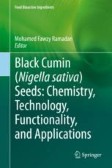Search
Search Results
-
Identification of a female-produced pheromone in a destructive invasive species: Asian longhorn beetle, Anoplophora glabripennis
Male-produced pheromone components have been reported in the Asian longhorn beetle, Anoplophora glabripennis (Motschulsky) (Coleoptera:...

-
Chemically-mediated colonization of black cherry by the peach bark beetle, Phloeotribus liminaris
The peach bark beetle ( Phloeotribus liminaris Harris, PBB) affects the health, quality, and value of black cherry ( Prunus serotina Ehrh.) within the...

-
Aroma Composition of Aniseed and Aniseed-Flavored Beverages
Pimpinella anisum L. is an aromatic plant that has been used in the human diet for thousands of years in the flavoring of food and alcoholic...
-
Volatile Compounds and Oils from Mosses and Liverworts
Bryophytes are small, non-vascular plants, such as mosses, liverworts, and hornworts. They play a vital role in regulating ecosystems; some bryophyte...
-
Volatile Compounds and Oils from Mosses and Liverworts
Bryophytes are small, non-vascular plants, such as mosses, liverworts, and hornworts. They play a vital role in regulating ecosystems; some bryophyte...
-
Head-Space Volatile Milieu from Leaves: A Case Study of Eggplant Infestation by Mealybug
The phloem-feeder mealybug, Coccidohystrix insolita (Green, 1908) is a common herbivore which causes economic loss in crop yield every year in India....

-
Herbivore-Induced Volatiles from Maize Plants Attract Chelonus insularis, an Egg-Larval Parasitoid of the Fall Armyworm
Chelonus insularis (Hymenoptera: Braconidae) is an egg-larval endoparasitoid that attacks several lepidopteran species, including the fall armyworm...

-
Chemical Ecology of the Asian Longhorn Beetle, Anoplophora glabripennis
The Asian longhorn beetle (ALB), Anoplophora glabripennis (Motschulsky), is a destructive forest pest in its native range, East Asia, or a high-risk...

-
Phytochemical analysis and anti-UTI activity of essential oil from meta-topolin-induced micropropagated Artemisia vulgaris L.
Artemisia vulgaris is a medicinally important essential oil–yielding plant belonging to Asteraceae, used as a traditional remedy against chronic...

-
Emissions of biogenic volatile organic compounds (BVOCs) from the rhizosphere of Scots pine (Pinus sylvestris) seedlings exposed to warming, moderate N addition and bark herbivory by large pine weevil (Hylobius abietis)
AimsBiogenic volatile organic compound (BVOC) research has been mostly focused on foliar emissions. In this experiment, the main focus was on...

-
Hairy root induction in Calotropis procera and optimization of its phytochemical characteristics by elicitors
This work centered on develo** an efficient hairy root induction system to achieving a high production capacity of specialized metabolites in Calotro...

-
Antibacterial and In Silico Evaluation of β-lactamase Inhibitory Potential of Pinus sylvestris L. (Scots Pine) Essential Oil
Antibiotic resistance remains one of the global challenges that needs urgent attention, including finding alternative treatment options to...

-
Evaluation of synthesized magnetic nanoparticles and salicylic acid effects on improvement of antioxidant properties and essential oils of Calotropis procera hairy roots and seedlings
Calotropis procera (Aiton) W.T.Aiton presents high levels of medicinally important terpenes and phenolics with antiinflammatory, antimicrobial, and...

-
Composition and Functionality of Nigella sativa Essential Oil
Nigella sativa L., whose seeds are known as black cumin, takes place in the Ranunculaceae family and has been grown in different regions of the world...
-
Improving salinity tolerance in Salvia officinalis L. by foliar application of salicylic acid
BackgroundHigher absorption and translocation of sodium (Na) and chlorine (Cl) ions in plant tissue can lead to serious physiological and biochemical...

-
Unveiling the potential of native arbuscular mycorrhizal fungi for growth promotion and phytochemical enrichment in Valeriana jatamansi Jones
Medicinal plants are rich sources of pharmaceutically important compounds and have been utilized for the treatment of various diseases since ancient...

-
Insecticidal activity of the essential oils from yarrow (Achillea wilhelmsii L.) and sweet asafetida (Ferula assa-foetida L.) against Aphis gossypii Glover. (Hemiptera: Aphididae) under controlled laboratory conditions
The essential oils of two medicinal plants from yarrow ( Achillea wilhelmsii L.) and sweet asafetida ( Ferula assa-foetida L.) were studied for...

-
The effects of foliar application of chitosan on the morphological and chemical characters of French lavender against water deficiency
French lavender has multiple biological qualities that are attributed to it being a source of natural products that are used for medicinal and food...
-
Nigella sativa Seed Extracts in Functional Foods and Nutraceutical Applications
Plants are used as traditional medicine for curing various diseases. Medicinal plants are used in formulations of herbal drugs due to their safety...
-
Cananga odorata (Lam.) Hook.f. & Thomson Annonaceae
var. odorata: Canangium mitrastigma (F.Muell.) Domin; Canangium odoratum (Lam.) Baill. ex King; Canangium scortechinii King; Fitzgeraldia...
